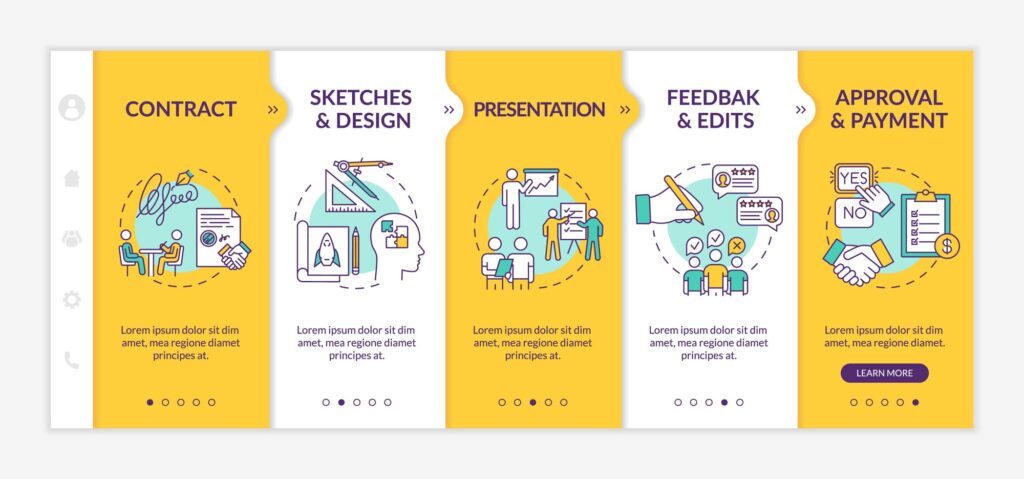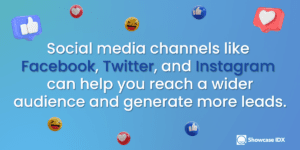To learn how to grow your digital marketing agency, you must utilize the nine proven ways described below.
One of the best ways to grow is to bring attention to yourself by improving where people find you in internet search rankings. You also need to have good retention methods once people land on your site. Your site should create an experience that encourages people to share with friends and colleagues.
The steps below will help you get through what, at first, seems like unnavigable wide waters. Once you get the hang of things, getting ahead and growing a digital marketing agency is far from an impossible task with the focus on the right SOPs and with a solid tribe of like-minded people around you.
1. Create Lead Magnets for Your Site.
One of the first new skills to master is creating lead magnets for your site if you want to know how to grow your digital marketing services.
One example of a lead magnet many people have seen is landing on a cryptocurrency website and seeing a link to the whitepaper at the top. Many people want to learn more for free before investing, so resources like whitepapers provide all the relevant information without commitment.
How Does Lead Magnet Works
A good lead magnet differs from a link to a whitepaper by employing an effective strategy to collect an email address from potential clients. For example, HubSpot offers a website grader where you can input your website URL and get your score via email.
The process is that easy. You now have a lead in the form of an email address. The service you supply capitalizes on the fact that people love rankings, and everybody with a website wants to know how they compare.
Most importantly, the service is free because there is no upfront cost. With the email address, you can now nurture a client through a sales funnel.
Always give plenty of free resources. People love to do research before parting with any of their precious money. They want to know what you offer, how quickly you complete projects, and the cost of everything. Always be transparent about pricing to avoid upsetting people with hidden costs.
Realize that most visitors do not convert to paying customers, so you need to offer the best service possible to the ones you do get.
Retargeting
While talking about people visiting your website, let’s look at retargeting. You may have noticed that you cannot go anywhere on the modern internet without consenting to or declining cookies.
Cookies and other methods allow retargeting to place ads in front of users to remind them of sites they have visited. Sometimes a potential customer has an “oh yeah” moment and ends up back on a website they forgot existed.
This form of advertising borders on creepy, so you must avoid being intrusive at all costs. You want this to be like when you smell a food you didn’t know you were craving, and then you remember how good that food tastes.

You will need to find out what interests different people, so you can attract them with the information they want. For example, if someone has only read your blog, they are still at a stage of awareness and are just learning about you.
When people move forward from awareness, you will see that they check your “About Us” section and look at your service page to evaluate your company.
When people move on to your contact page, even if they leave, they are thinking about making contact and are potential customers.
Since people fall into these different categories, you can offer options like a blog, whitepapers, and case studies to move people along in steps and convert potential clients into paying customers.
2. Publish Blog Posts Regularly
Several times a year, articles seem to come out of nowhere talking about how guest posting is dead. Someone seems to wish the practice would die and writes out their fantasy.
In reality, guest posting is still alive and well, even if its popularity is no longer peaking. Just because something is not as popular as before, does not mean you throw the baby out with the bathwater.
Generating leads is like having a big tool bag. Some tools get used more often and are more important than others, but you still use and need every tool.
Guest blogging might be a slightly lesser tool, but you should pursue every avenue that generates leads.
Content is King: The Benefits of Blogging
Blogging in general is a good way to generate leads as well. People move toward becoming customers with creative agencies in stages. Checking out your company blog is an early stage when potential clients are learning who you are and beginning to evaluate you.
Even if SEO is not part of your strategy, having search-optimized content in blog posts helps drive traffic to your site. 93% of web traffic comes from curious people who use their search engine to find something they want to learn more about.
Successful agencies know that not attracting new business clientele through SEO in blog posts is like throwing money away. Learning to rank for SEO is also a new skill that a company can learn. Any new skills learned, may become services a company can offer down the road.
The other reason to actively blog is that if your content is good, you can become an expert in your field. All you need is for people to have that perception. Once you gain a reputation as an expert, reputable publications might ask you to write advice or opinion pieces.
Once you get established as a place people can trust, leads will begin to find you and ask for your services. In some cases, you will be able to bypass the sales funnel altogether.

The other advantage to having blog posts is that your employees, clients, and even prospective clients can share your articles. Sharing spreads you around and gives you a larger internet presence. The amount of exposure you get from a few people sharing your posts would take a single person many hours to accomplish.
Lastly, a quality blog helps you bring in new business by building trust. The trust you build affects both your client base and prospects. Remember that you need to keep current clients onboard by continually gaining their trust.
You want prospects to choose you because they trust you. Prospective clients use blogs and other forms of lead generation to see what you are offering. At this stage, these potential clients are nowhere near visiting your contact page.
If they begin to trust your brand, they will likely move on to resources such as your “About Us” page. If you are blogging, and your analytics show traffic that moves from your blog to your company profile-type information, you are almost at the stage of having a potential client.
3. Streamline the Client Onboarding Process
Client onboarding is a critical process that can waste a lot of your time and wear you out if you do not streamline the steps. One great method is to make a list, but whatever you do, have everything ready to run as efficiently as possible.
The outcome of a smooth onboarding process should be that all parties clearly understand what will and will not happen. Both parties should agree on everything, and all questions should get answered. Your agency will look more professional and eager to help if you streamline the onboarding process correctly. You will be happy, and clients will be happy and at ease. Follow us as we guide you through the step-by-step process:
Step 1: Contract and Payment
The first order of business is to get to the contract and payment. The contract is the only way for the business relationship to become official. A handshake is as good as a contract to some people, but nothing can replace a contract.
While you can square away a contract in person, you can also get a contract signed online through various services. While upfront payment is optional, requesting a deposit before the contract is not a bad practice.
Once the contract and payment are out of the way, you can move on to an internal meeting to discuss the project. By the time the meeting finishes, you should have assigned tasks, and nobody should have any lingering questions about the client’s wishes.
The internal meeting does not perfectly address all the needs of the client. You will need more information to reach that stage.

Step 2: Onboarding Questionnaire
The next step is to send the client an onboarding questionnaire. You could wait for the internal meeting until after the client finished the questionnaire, but the process may take 5-10 days. Many agencies feel that when the contract is ready, up to 10 days is too long to wait for the internal meeting about the project.
Regardless, you need to get the questionnaire back soon for client case studies, so you can ask the client to return the questionnaire within 10 days. Do not make the mistake of sending an overly long set of questions. Between ten and 20 questions should work. Do not exceed 20 questions because the client might feel burdened.
Once you get through the questionnaire stage, you have completed most of your face-to-face interaction with the client.
Step 3: Set Up Client Reporting
The next phase of communication is to set up client reporting. Reporting means that you give your clients reports with statistics and analytics results.
These reports show the client how their rank has risen and how you are driving their business forward. You should be able to automate this reporting process to make less work for you while showing the client what you are doing for them.
Step 4: Automate the Set Up
The next step goes hand-in-hand with client reporting: Use software that automates the project setup. Automation means you can upload everything the client wants and add or remove sales team members. You can also integrate milestones that motivate the team.
Step 5: The Project Launch Meeting
The last step is to have a project launch meeting. This is where the client and team members can meet, and the team members can explain the steps they will take to fulfill everything the client wants including the answers given on the questionnaire.
4. Think About the Other Channels You Could Use for Promotion.
Nowadays, there are more places to launch marketing services than ever before. If you want to launch a successful campaign, you need to market cross-platform which includes mobile apps and email campaigns.
The other aspect of this omnichannel approach that many people forget about is the process means you will have an audience, and you can interact. Interacting means that you give your target audience what they want, as long as you take the time to listen.
Social Media & Podcasting

Social media and podcasting are great ways to get audience feedback. You might need help from a social media agency. Also, as everyone knows, you have a larger presence when you experience growth online. This means more people sharing your links and attracting new traffic.
Do not forget about algorithms either. Many sites have algorithms that drive new traffic to content that is growing. When your company experiences this growth and appears to be an authority on digital agencies, clientele, and client referrals both improve.
Influencer Marketing
Another avenue you can explore is influencer marketing. Chances are, everybody has seen this type of marketing campaign when watching one of their favorite content creators on YouTube or another video site.
A content creator usually makes a commercial near the beginning of a video. The ad runs quite similarly to a commercial where the creator promotes the product, usually in a funny way.
You can also stick with old-fashioned advertising but improve the reach by including more social media platforms. You can get ads on Spotify, Pinterest, Snapchat, and many more.
Experiential Marketing
You can also try experiential marketing. Engagement marketing and participation marketing are two more names for the same thing. This type of marketing invites people to interact personally with a brand.
By marketing in this participatory way, would-be clients can learn what a company offers and what ideas and goals define what the brand stands for and wants to accomplish.
The other advantage of this type of marketing is gaining data from witnessing direct interaction. Maybe a handheld product has a place for the thumb to rest, and nobody notices the flawed design until somebody comes along and mentions that the product feels wrong in their hand.
This type of data is invaluable, and some companies spend a fortune to work these kinds of experiences into their R&D during the product development stages.
You can also blend experiential marketing with other content marketing strategies, such as completing social media posts. If potential customers are having a great time trying out a product, you can upload happy videos that contain “wow!” moments to a site like Twitter.
You can also work on making a hashtag part of your branding, and videos you upload with the hashtag can instantly reach more people and devices.
Email Marketing
If you have a good lead magnet, as discussed previously, that collects email addresses, you can also spread content through emails. You should place yourself on multiple paths at once. A few people come in from one source, a few more from another, and pretty soon you have attracted a substantial amount of attention.
5. Optimize content for SEO.
 There are many ways to optimize for SEO. You can simply use Google and look at what comes up near the top and which questions the search engine answers. But, there are more sophisticated ways such as a keyword research tool. Read about some of them below.
There are many ways to optimize for SEO. You can simply use Google and look at what comes up near the top and which questions the search engine answers. But, there are more sophisticated ways such as a keyword research tool. Read about some of them below.
Local Keywords
One of the most important ways to rank currently is to use local keywords. Many businesses notice that they have to rank in the top three to see any real benefit. Local keywords help SEO because they give insight into the items people search for in a community.
We will look at local keywords more in a dedicated section below because they are so important. Local keywords are not the only optimization you can do to find success locally.
Structure Data and Backlinks
You can also use structured data generated by local businesses and post backlinks from those businesses. Structured data works with Google algorithms efficiently to make your site more visible in search results.
The process gets into how computer programming works by using names like JSON-LD, which we do not need to cover here. You end up with structured company information you can copy and paste onto your website. The structure of the data allows Google to find you more easily.

Google takes backlinks into account when providing search results. Many people overlook backlinking, but the practice is very important. When you have backlinks to local businesses on your website, you can get a boost in search results.
The trick is to have good backlinks to related sites. Google decides how much to promote you based on the number of related backlinks to quality sites.
Consider How People Search
Another method to optimize SEO is to look at the ways people search. Some people prefer mobile devices, and some prefer laptops or PCs. Mobile devices allow people to do voice searches which you can optimize.
Long-tail searches are searches that use more words. These are probably more common in voice searches. For example, a person could search using the words “Ford Mustang.” Instead, they search for “Where can I buy a Ford Mustang?” People who use the whole question are why optimizing for long-tail searches is important.
A good way to start when trying to optimize for long-tail is to create questions using keywords that apply to your product and fit the words into basic question sentences. “What,” “where,” and “how” questions will probably give you the best return. You can still use a question word like “who” if that word seems to be the most appropriate.
Meta Description and URL Optimization
Optimizing SEO in blog posts is not the only place that you can improve. You can also optimize meta descriptions and URLs. In the blog post, do not forget the importance of an optimized title.
The reason the title, URL, and meta description are important is that if you take a second and look at what Google shows in search results, you will see those three things.
If you combine local keywords that apply to your products and optimize the title, URL, and meta description to match, you have gone a long way toward getting your content to rank well.
6. Leverage online directories

One thing that business owners must know about appearing in directories is that Google monitors the information for consistency. If there are inconsistencies, Google algorithms might become suspicious that you are not a legitimate company and demote your ranking.
Keep Information Accurate and Consistent
Examples of inconsistent information are often little details like putting your company name and “LLC” or “Inc.” in one place and forgetting it in another. You cannot have two different phone numbers listed in different places or Google worries about supplying accurate information.
Have a place where you keep your official contact details, name, etc., and always copy and paste from that place when you list yourself in a directory. If there are any changes in the future, you have to go back and make sure every directory says the same thing.
The only information Google has to verify your company is what you put online. Google strives to provide accurate information, so the algorithm favors every directory listing of your company to have the same information. If you mess up this small detail, being in directories may do you no good.
Start with Local Directories
As stated above about the importance of using local keywords, getting into local directories is equally important. Other directories that are not local are important too, but you cannot overlook the local ones.
One of the simplest ways to start with a local directory is to join the chamber of commerce in your area. Joining automatically gets your website into its directory with an authoritative backlink. As a bonus, you gain more credibility in the community.
As far as the broader world of directories goes, the practice of getting into a directory used to mean your business details ended up in a real book that got delivered to people. That practice is now a dinosaur, and everything is online these days.
However, the concept of a person who needs something finding your product in a directory is no different. Currently, more than 50% of online searches start in a place like a directory or by searching online reviews.
With those kinds of numbers being the reality, you cannot afford to get in one directory and consider yourself listed. Directories play a key role in search engine rankings by supplying backlinks.
The Role of Backlinks
You want as many of these backlinks online as possible as part of your growth strategy. You want to get into compatible directories that fit your business to get boosted. The trend now is local, so getting into a Memphis directory when your business is in Nashville will not help much.
While the most important directories are local, you might find other directories that make a great fit, regardless of the importance placed on locale. First, you need to find relevant directories.
If you search for the word “directory” you will get millions of hits and never get anywhere. Instead, search for a directory in your city. Look at the first thing that comes up. No surprise, the chamber of commerce is at the top of the list. There are other directories too, so this method is a great place to start.
7. Showcase case studies from your successful clients
Nothing makes better-bragging rights than a list of stories from satisfied clients. Developing the list takes time for new companies, but these testimonials carry a lot of weight. New companies should wait until they have at least three successful clients to post case studies.
You can link to case studies from your homepage, but the studies need a dedicated page, so you can create a setting. You should incorporate lead magnets and data to back up your claims. People who read these studies will want to know exactly how you helped the client.
Some companies find the idea of putting together detailed case studies daunting, so there are tools that make well-designed case studies for you. You want to get the story out, but you want the stories to lead to conversions, so use a tool if you need one.
One of the most important things to remember about case studies is that they differ from blog posts by telling people who want to be more successful about other people who you helped to become successful. These are success stories. A blog post can be similar, and then the next post can be about something different.
Your successful clients should take on an almost superhero-like status. Clients will also appreciate being the center of attention which leads to more sharing and word-of-mouth promotion for your company. You should see more referrals from case studies.
What Makes a Good Case of Study?
A good case study will grab the reader’s attention and compel them to read until the end. They should want the whole story.

Well-structured case studies also build credibility and help you stand out from the competition. Case studies give you an advantage over your competition, especially if they do not have any studies. Your competition will probably have case studies too, so yours have to be better.
Another benefit of case studies is that you can optimize the success stories of local clients and spotlight their brand names. Local clients will feel even more compelled to share your case study if doing so helps their brand.
When you are ready to start working on a case study, one important thing to do is review your successful clients and try to find the most ideal people for an inspirational story. Along with the story, think about the type of work you want to do more of in the future.
If you like doing a certain type of work, and you make a case study about a success story in that niche, you will attract more of that kind of work. You can use this tactic to highlight your favorite types of work and stay quiet about work that does not interest you.
You should gather all the relevant information and do an outline just like you learned in school. If you follow these basic steps, you should end up with memorable case studies.
8. Optimize your website
With all of the optimization going on, you should not feel surprised to find out that your website needs the same care everything else does. First, impressions matter, and when people land on websites that do not look good or feel awkward to navigate, the memory stays.

The other aspect of optimization is that there are so many devices and browsers people use. If you want to have the farthest and most effective reach possible, your website has to work on every mobile device, laptop, PC, and more browsers than just Chrome.
When we go shopping in a store, we can shop with our eyes, ears, nose, and fingers. Online, we primarily shop with our eyes. Sometimes we shop with our ears too, in the case of video. A website that is lacking from a design perspective is like trying to shop in a packed store where walking is difficult.
Perhaps the products are fine, but the crowded aisles are getting annoying. Add some ugly colors, and you have something similar to landing on a website that falls flat.
Most people make a near-instant evaluation of a site by appearance alone. You cannot afford to have that first impression be lackluster or negative. A prospective client may overlook the design flaws and move forward, but there will always be people who leave for good.
Compare and Evaluate
One of the best ways to see how competitive you are is to do a comparison. Visit some of the leading marketing agency websites and see how you stack up. Note features they have that you like, but note what you do not like as well so you can avoid the same mistakes.
Many different aspects go into a well-designed website. A good place to start is to have a clear message. Bear with me for a second as we take a side path with a relatable story.
Agents are the frontline in the book publishing industry. When new authors approach agents, many agents ask authors to sum up their book in one or two sentences. If the author cannot succinctly convey the plot, the agent assumes the author failed to create a story with a clear beginning, middle, and end.
The same applies to the clear message your marketing website should convey. Yes, you offer many services. Yes, you could devote many paragraphs to explaining your work. However, if you cannot sum up your company in one brief, clear message, your company may need a greater sense of purpose.
Having a clear message takes us to the next step, do not have a website with clutter. Related to clutter, use intuitive navigation that feels easy. Do not have any button-looking parts that are unclickable, and only use sharp images that look great.
Lastly, think about font and text size. Everybody has landed on websites with a large banner that is easy to read, followed by small text that forces you to zoom in on the page. Everything on a well-designed site should be easy to read.
9. Optimize for local keywords
As we touched on earlier with local keywords, choosing the right words is part of ranking well in search results. Ranking well is critical because most people do not have time to scroll through multiple pages to find what they want.

Local keywords are so important because nearly half of all searches have to do with something local. Out of those searches, a majority of people end up traveling only a few miles from home. In addition, almost every internet user has searched for something nearby at some point.
Most people only read the first few search results or choose something on the first page. A big part of your strategy should be to rank on the first page and crack into the top three if possible.
Local keywords vary by geography, population, economy, etc. A rural area dotted with small towns might have more people searching for agricultural, farming, or homesteading items. As you move toward cities, searches will broaden to include almost everything.
You have to stay on top of which keywords apply to your local economy, work those keywords into writing with SEO, and generate traffic for your site or foot traffic for a business.
Utilizing local keywords also creates awareness. Awareness almost guarantees future business from people who do not need a product currently but may in the future. One of the first stops, if not the first, will be a place a person already knows exists.
You also need to get a GMB (formerly Google My Business), now called a Google Business Profile (GBP). A GBP profile is another way to make a business stand out locally.
The Power of a Google Business Profile (GBP)
Here are a few things you can do to harness the power of a GBP profile. You can ask satisfied clients to leave reviews. Getting reviews takes time, and some people do not have the patience to leave a review.
If you imagine that somebody sees your company with a dozen positive reviews versus another company that may not have any reviews, you instantly look far more credible.
Stay away from all spam-like tactics. Google algorithms have gained enough sophistication to spot everything from keyword stuffing to doorway pages.
Paying for fake reviews will also guarantee a demotion in search rankings. Google and review sites have algorithms that can spot fake reviews. Your site will receive a flag that pops up and warns people not to trust you. Save your money and earn authentic reviews.
The last two recommendations are to politely respond to negative comments and use GBP tools to maximize your presence. There are many free tools to use such as posters, stickers, and social media posts. Remember to update regularly with new posts.
Form these strategies into a combined effort, and your presence will improve.
FAQs: How to Grow Your Digital Marketing Agency
If you’ve been looking for tips on how to grow your digital marketing agency, you may have more questions than we can cover here, but these questions get most people off to a good start.
How do I start and grow a digital marketing agency?
The first thing you have to do is find potential clients and convert them into satisfied, happy customers. Getting clients is all about making yourself stand out in every way. Your website must look great. You need good lead generation. You have to have a good internet search ranking which involves many steps. Once you have a few satisfied clients, you can use their stories to gain more clients.
How can I succeed as a digital marketing agency?
A successful agency involves a lot of hard work while working smart because you use the right tools. The right tools lead people through sales funnels and generate conversions.
One of the most important tools is utilizing the power of the internet so new people find you. Once those people find you, they need to like how your site looks and the high-quality information you offer. If everything comes together, you can convert window shoppers into clients.
How do I get clients for digital marketing?
The process begins with word of mouth, people sharing your site, backlinks, and ranking well in internet searches. Once people find you, you need a good sales funnel that turns prospective clients into paying customers.
How do you grow an agency?
The digital marketing industry is taking off. Growth comes in many ways, but nothing is more important than satisfying the clients you already have. If you know you rank well in Google searches and have everything set up to maximize local exposure, focus on making happy clients. Happy clients share your site and tell other people about their great experiences.
How can we grow our new digital agency?
When you are new, you have to try and get a good search ranking online, set up good lead generation, and gain a good reputation locally.
One of the first things you should do is to join your local chamber of commerce. This one step should help people start to find you right away.






